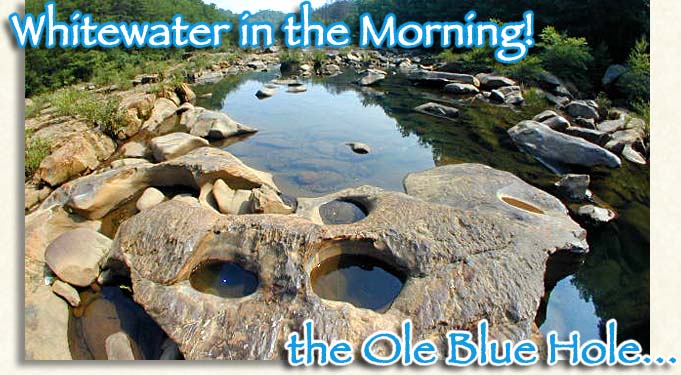
Whitewater in the Morning at the Ole Blue Swimmin Hole....Mid-summer heat on a dog day afternoon... visibility fades into a heavy mist hanging densely over the mountains of the southern Blue Ridge...the summer season is at its height.
Deep within the Cherokee National Forest of southeastern Tennessee's Polk County, is an ancient gorge lined with steep rock walls twisting along the cutting path of the Ocoee River's whitewater paradise.
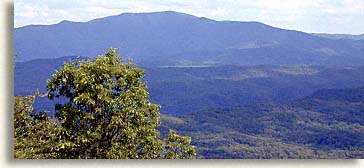 The
Ocoee River starts its journey in upper Polk County in the mining town
of Copperhill where the waters of North Georgia's Toccoa River takes a
name change as it crosses the state line into Tennessee. Seeking a way
to the lowlands of the Tennessee Valley, the Ocoee River follows a gap
through the Cohutta Wilderness carving an ever-deepening gorge. The gorge
evolved over
The
Ocoee River starts its journey in upper Polk County in the mining town
of Copperhill where the waters of North Georgia's Toccoa River takes a
name change as it crosses the state line into Tennessee. Seeking a way
to the lowlands of the Tennessee Valley, the Ocoee River follows a gap
through the Cohutta Wilderness carving an ever-deepening gorge. The gorge
evolved over 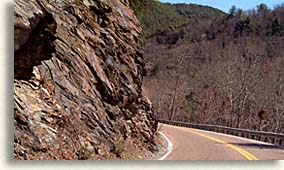 eons
of time as a result of the torrent rush of whitewater.
eons
of time as a result of the torrent rush of whitewater.
Cruising along the lower level of the gorge is Highway 64 traveling the northern banks of the Ocoee River, following an ancient Native American trail turned miner's road known as the Old Copper Road. Yet another name for this engineering marvel is the Ocoee Scenic Byway. The Byway skirts along the northern banks of rushing whitewater, enormous rough honed rock faces jet out into the highway causing the pavement to traverse sharply around blacktopped curves.
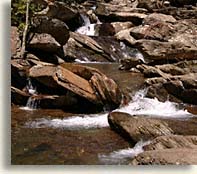 Numerous
small waterfalls cascade down the walls of the gorge gathering in ditches
and funneled under the road, and into the river. It's even more spectacular
after a rainfall when heavier waters accumulate from higher altitudes
causing springs to shower intensely down the walls of the gorge.
Numerous
small waterfalls cascade down the walls of the gorge gathering in ditches
and funneled under the road, and into the river. It's even more spectacular
after a rainfall when heavier waters accumulate from higher altitudes
causing springs to shower intensely down the walls of the gorge.
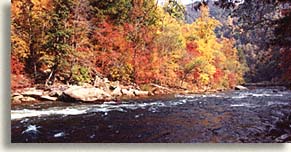 The
season changes makes any drive through the gorge a breath taking experience,
spring dogwood cling to fragile soil along with the green budding of other
hardwoods, summer is the atmosphere of a rain forest with river enthusiasts
at every turn, autumn is a palette of color rising sharply against the
gorge's steep walls, creating the sense of an all day sunset, winter is
barren with walls of granite baring the scares of the ages with pride
and dignity.
The
season changes makes any drive through the gorge a breath taking experience,
spring dogwood cling to fragile soil along with the green budding of other
hardwoods, summer is the atmosphere of a rain forest with river enthusiasts
at every turn, autumn is a palette of color rising sharply against the
gorge's steep walls, creating the sense of an all day sunset, winter is
barren with walls of granite baring the scares of the ages with pride
and dignity.
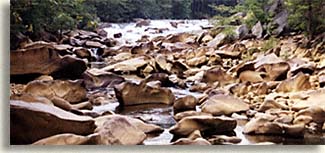 The
real excitement of the Ocoee Gorge isn't the river but what's on the river...whitewater
river rafters and kayakers. Each morning the river runs, a flow of water
steadily increases as water is released from the upper dam. You can stand
on the banks and watch as the water builds a momentum as the river takes
on its character as a "ragging whitewater river." Professional
rafters call this first water in the morning "catching the surge,"
a different experience in whitewater rafting.
The
real excitement of the Ocoee Gorge isn't the river but what's on the river...whitewater
river rafters and kayakers. Each morning the river runs, a flow of water
steadily increases as water is released from the upper dam. You can stand
on the banks and watch as the water builds a momentum as the river takes
on its character as a "ragging whitewater river." Professional
rafters call this first water in the morning "catching the surge,"
a different experience in whitewater rafting.
Commercial
rafting 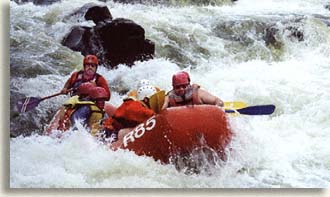 companies run the river with tens of thousands of rafting adventurers
a year, on a good year the Ocoee serves over 250,000 customers. All rafting
trips are performed by licensed rafting companies, and are regulated by
the Cherokee National Forest and the TVA electric power company. Kayaker's
can use a local outfitter, or bring their own equipment. The Ocoee River
is a serious river with rapids rating at level Grade 5, professional rafting
guides are required to be trained and kayakers should be experienced before
taking on the Ocoee River's more challenging rapids.
companies run the river with tens of thousands of rafting adventurers
a year, on a good year the Ocoee serves over 250,000 customers. All rafting
trips are performed by licensed rafting companies, and are regulated by
the Cherokee National Forest and the TVA electric power company. Kayaker's
can use a local outfitter, or bring their own equipment. The Ocoee River
is a serious river with rapids rating at level Grade 5, professional rafting
guides are required to be trained and kayakers should be experienced before
taking on the Ocoee River's more challenging rapids.
Commercial
whitewater rafting on the Ocoee River begins each year in late March and
goes to November. 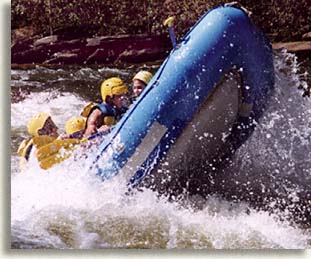 Occasionally, when I'm passing through the gorge I'll
stop at one of the narrow pull offs along the upper banks of the river
and look for a crude path that will take me down to the river banks where
some of the best rapids are hidden from view, you'll usually find one
of the local rafting companies photographers hanging out waiting for a
particular group to pass by. After a few minutes pass the expectant rafters
come into view yelling and screaming while the rafting guide takes them
through a roller coaster of churns and upheavals, arriving on the safe
side of the rapids waving hands, arms and oars, posing for the picture
of victory they'll show the folks back home. All the while the guides
stare over at the photo bugs with tongue in cheek and grins of, "I've
been doing this all day."
Occasionally, when I'm passing through the gorge I'll
stop at one of the narrow pull offs along the upper banks of the river
and look for a crude path that will take me down to the river banks where
some of the best rapids are hidden from view, you'll usually find one
of the local rafting companies photographers hanging out waiting for a
particular group to pass by. After a few minutes pass the expectant rafters
come into view yelling and screaming while the rafting guide takes them
through a roller coaster of churns and upheavals, arriving on the safe
side of the rapids waving hands, arms and oars, posing for the picture
of victory they'll show the folks back home. All the while the guides
stare over at the photo bugs with tongue in cheek and grins of, "I've
been doing this all day."
Personally I shoot few victory shots, mostly I'm looking for that shot that bends the bowel of the raft back to an almost vertical position just before it slams down on the river, I'm not looking for smiles I'm looking for the pure adrenaline rush on their whitewater faces.
Whitewater rafting is the adventure you'll write home about, it's fun, it's exciting and affordable. Local commercial rafting companies can set you up with a trip down the Ocoee River along with a variety of other local adventures available in this region of the Blue Ridge Mountains of Polk County, Tennessee.
The Ocoee River is divided into three section, The "Upper Ocoee" with its Olympic Course, and rapids up to a class 5, runs on weekends from April 24th through October 31st. The "Middle Ocoee," is a wild untamed river with rapids up to a class 4 with names like "Grumpies," "Double Suck," "Table Saw" and "Diamond Splitter.'' Rafting the "Middle Ocoee" begins each year on the last weekend in March and continues to open on weekends till Memorial Day when the schedule runs Thursday thru Mondays. Labor Day the Ocoee River returns to Saturdays and Sundays till the first weekend in November. The "Lower Ocoee," is a section of the river that flows gently into Ocoee Lake, there is no commercial rafting, but is open to the public, kinda a byob, "bring your own boat".
Check out the Ocoee Water Release Schedule.
To plan your whitewater adventure contact: Great Mountain Adventures.
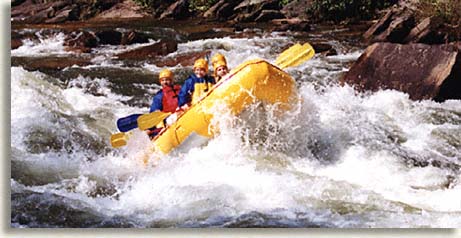
What makes a river run wild?
If you've ever wondered about what makes a river run wild, does the rushing power of white capped water do a free-standing act above the river's current? The "Upper Ocoee River" is a beautiful example of a natural wonder, a skeletal display of the raw under-belly of a prehistoric river. Jumbo boulders cluster together to form the treacherous bed of a high-powered whitewater river that often lies dormant within the confines of the Ocoee Whitewater Center and Olympic Park.
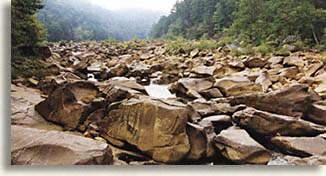 This
tamed section of the Ocoee River became a dry-bed in 1910. The entire
Ocoee River was deeded for the development of hydroelectric production.
In 1913, water from the upper Ocoee River was diverted away from this
spot of the riverbed, the construction of a wooden water flume, was used
as a method to consolidate water.
This
tamed section of the Ocoee River became a dry-bed in 1910. The entire
Ocoee River was deeded for the development of hydroelectric production.
In 1913, water from the upper Ocoee River was diverted away from this
spot of the riverbed, the construction of a wooden water flume, was used
as a method to consolidate water.
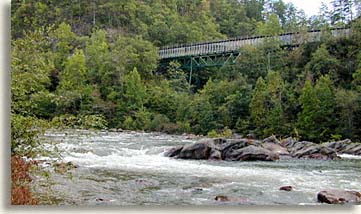 The
water box runs along the upper southern walls of the Ocoee River Gorge,
visitors often see the box as a rail road carved into the granite wall
with trestles crossing small side gorges delivering pressurized water
to a hydro-power plant several miles down the river disrupting the natural
flow of the river for decades. Today the Tennessee Valley Authority control
the current of the upper, middle and lower Ocoee River for the use of
hydroelectric production, commercial rafting and recreational kayaking
and slalom canoeing.
The
water box runs along the upper southern walls of the Ocoee River Gorge,
visitors often see the box as a rail road carved into the granite wall
with trestles crossing small side gorges delivering pressurized water
to a hydro-power plant several miles down the river disrupting the natural
flow of the river for decades. Today the Tennessee Valley Authority control
the current of the upper, middle and lower Ocoee River for the use of
hydroelectric production, commercial rafting and recreational kayaking
and slalom canoeing.
By nature the Ocoee River and Gorge is a wild spectacle of dramatic beauty. The rushing power of whitewater rapids displays the immense force that water pressure has had in wearing away hardened stone boulders and shaping the floor of the Ocoee River Gorge.
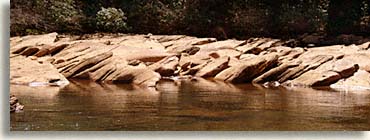 During
the late evening and on Tuesdays and Wednesdays when Ocoee Dam no. 3 holds
the water back, the Ocoee River exposes the naked underbelly and deep
scars carved by this force of water over eons. The scene of the dry riverbed
is mysteriously macabre, purely surrealistic. Misplaced sharp rigid rocks
and water worn boulders give way to a scene of stones that in some areas
appear to be set in a layout of a natural symmetry. River stones of approximately
equal proportions lay side by side in the order of what seems more in
the making of a fine tooled plan rather than the undaunted mind set of
a torrent river.
During
the late evening and on Tuesdays and Wednesdays when Ocoee Dam no. 3 holds
the water back, the Ocoee River exposes the naked underbelly and deep
scars carved by this force of water over eons. The scene of the dry riverbed
is mysteriously macabre, purely surrealistic. Misplaced sharp rigid rocks
and water worn boulders give way to a scene of stones that in some areas
appear to be set in a layout of a natural symmetry. River stones of approximately
equal proportions lay side by side in the order of what seems more in
the making of a fine tooled plan rather than the undaunted mind set of
a torrent river.
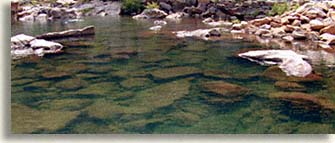 The
stillness of the dry Ocoee River rivals in splendor to the untamed grandeur
of the wild Ocoee River, for it reveals the heart of the matter unseen
by the deluge of its turbulent presence. Within the intimacy of its dry
rocks and sandy pockets small streams of water gently cascade over and
between low rocks along the river, gathering in shallow and deep pools.
All the while, small schools of fresh water fish linger in the cool waters
of its inviting depths.
The
stillness of the dry Ocoee River rivals in splendor to the untamed grandeur
of the wild Ocoee River, for it reveals the heart of the matter unseen
by the deluge of its turbulent presence. Within the intimacy of its dry
rocks and sandy pockets small streams of water gently cascade over and
between low rocks along the river, gathering in shallow and deep pools.
All the while, small schools of fresh water fish linger in the cool waters
of its inviting depths.
It's the "Upper Ocoee River," that draws my attention this day, the quiet solitude of the once long abandoned upper Ocoee fulfills both my need to explore the rivers ancient past but also affords me the time to reminisce about early days of my youth, taking the time to feel a sense of spiritual nexus with the land.
Along the southern banks of this once deserted Upper River, a monument stands to the potential of this once untamed piece of river wilderness. It's the stately Ocoee Whitewater Center. The center was built to accommodate the 1996 Summer Olympic Slalom Canoe/Kayak Events. During this historical event, the upper Ocoee River ran with wild rage, international crowds lined the banks and sat in the bleachers during the summer event of 1996, to witness the excitement of world-class competition.
Before the event could take place the upper Ocoee River bed had to be reconstructed to comply with the Olympic whitewater competition. To design and shape the flow of a rivers current is an engineering marvel in itself, accommodating the needs of thousands of Olympic fans is another matter entirely.
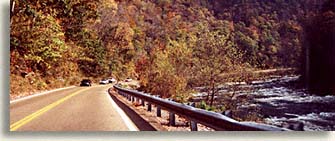 Gorges
are naturally narrow by nature making most river locations impossible
for reconstructing the rivers current for competition and spectators.
The problem of building an Olympic whitewater course on a natural whitewater
river is having too many curves and not enough width of dry land along
the floor of the gorge to accommodate a worldwide event.
Gorges
are naturally narrow by nature making most river locations impossible
for reconstructing the rivers current for competition and spectators.
The problem of building an Olympic whitewater course on a natural whitewater
river is having too many curves and not enough width of dry land along
the floor of the gorge to accommodate a worldwide event.
Located to the west, below Boyd Gap on US 64, were highway US 64 intercepts the Ocoee River is a level terrain were US 64 begins its snake like journey along the floor of the Ocoee River Gorge. It is at this point, were the road and dry Ocoee River meet, that would become the location of the Olympic event and were the Olympic Whitewater Center would be constructed.
The river gorge is naturally wide along this strip and curves gently through the gorge for at least a mile. The banks along the southern edge of the gorge are wide enough to allow, not only for highway improvements, but there was enough room between the river and the roads to construct spectator facilities and parking.
Construction on the river began with the meticulous fine-tuning of angles and alignments for boulder formations, to create competition lanes for the upcoming event. A small-scale experimental model was constructed in the park below Ocoee Lake Dam #1 on Highway 64 in lower Polk County, Tennessee. The constructed model remains in the park and is still operational.
The
jewel of the Olympic whitewater park is the state-of-the-arts 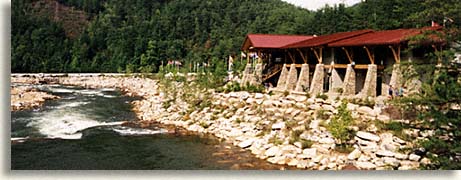 facilities
of the Ocoee Whitewater Center. This beautiful two-story building of rustic
design captures the attention of all eyes. The timber siding and stone
columns of the structure are completely conducive to the natural mountainous
terrain of the upper Ocoee Gorge.
facilities
of the Ocoee Whitewater Center. This beautiful two-story building of rustic
design captures the attention of all eyes. The timber siding and stone
columns of the structure are completely conducive to the natural mountainous
terrain of the upper Ocoee Gorge.
You enter the main
entrance through the upper level and walk into a large open room with
cathedral ceilings. The information counter is near the entrance, towards
the back of the open room are two separate walls of full glass windows
allowing a perfect over-view of the rivers course and a dramatic view
of the Ocoee River Gorge. Stairs lead to the lower level where there's
a fine gift shop and more large windows with a great view of the river.
Exiting the lower level you'll find yourself in the Ocoee River Park just
above the river. Paved trails lined with large stones lead down and along
the banks of the Olympic course.
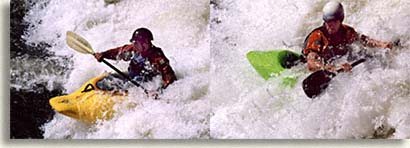 The Summer Olympic Whitewater Games became a moment in history, a footnote
in time. The renderings of that event have become the personal treasure
of this public owned park. Within the walls of the center are large photos
of the hallowed event, dedicated to the courageous hearts of the Olympic
challengers.
The Summer Olympic Whitewater Games became a moment in history, a footnote
in time. The renderings of that event have become the personal treasure
of this public owned park. Within the walls of the center are large photos
of the hallowed event, dedicated to the courageous hearts of the Olympic
challengers.
The upper Ocoee River is open on an average of 56 days a year for commercial rafting only, you can see what days by using our Water Release Schedule. Special "Whitewater Rodeo Events," for kayak and slalom canoe add additional days to the whitewater flow, bringing back the excitement of Olympic style competition.
During these events, dozens of flagpoles display the flags of the nations involved in the Olympic games; their brilliant colors can be scene flapping against a mountain backdrop of forest green.
The Tennessee Valley Authorities regulates and controls both the usage times and volume of water that flows through the upper Ocoee and Olympic Whitewater Center's water course for these special events. Check out the events and Water Release Schedule.
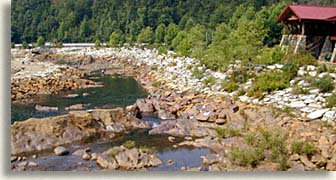 For
the most part, the upper Ocoee River rests peacefully these days in remembrance
of nearly 100 years of dormancy. During the river down time, the Olympic
Park has a "sleepy hollow" nature about itself, giving itself
over to the quiet times of long hot summer days. Within the confines of
the Ocoee Whitewater Center and its grounds is the daily operation of
a "visitors information center," along with the year round maintenance
of the U.S. Forestry Service.
For
the most part, the upper Ocoee River rests peacefully these days in remembrance
of nearly 100 years of dormancy. During the river down time, the Olympic
Park has a "sleepy hollow" nature about itself, giving itself
over to the quiet times of long hot summer days. Within the confines of
the Ocoee Whitewater Center and its grounds is the daily operation of
a "visitors information center," along with the year round maintenance
of the U.S. Forestry Service.
Along-side the Ocoee
Whitewater Center is a 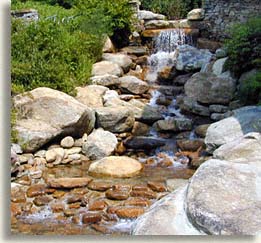 man made pool laden with boulders, from the upper
level, water spills over and cascades down boulder steps and into a reflecting
pool below. I might imagine that the waterfall's design could reflect
the natural watershed of springs and waterfalls,
bringing life to the river gorge.
man made pool laden with boulders, from the upper
level, water spills over and cascades down boulder steps and into a reflecting
pool below. I might imagine that the waterfall's design could reflect
the natural watershed of springs and waterfalls,
bringing life to the river gorge.
Connecting the white
water's center grounds to 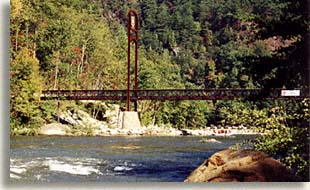 the opposite side of the Ocoee River is the
official Olympic bridge, known as the "Legacy Bridge." This
iron and cable bridge extends 330 feet across the river and offers a dynamic
view of the Ocoee River. Crossing the bridge offers access to an additional
10 mile system of mountain trails, ideal for both mountain biking and
hiking. On the opposite bank, you can stroll a short distance along a
paved path overlooking the Ocoee River to the Olympic Spirit Garden and
enjoy a picnic under a stand of eleven poplar trees dedicated to the eleven
Israeli athletes who died during the 1972 Summer Olympics.
the opposite side of the Ocoee River is the
official Olympic bridge, known as the "Legacy Bridge." This
iron and cable bridge extends 330 feet across the river and offers a dynamic
view of the Ocoee River. Crossing the bridge offers access to an additional
10 mile system of mountain trails, ideal for both mountain biking and
hiking. On the opposite bank, you can stroll a short distance along a
paved path overlooking the Ocoee River to the Olympic Spirit Garden and
enjoy a picnic under a stand of eleven poplar trees dedicated to the eleven
Israeli athletes who died during the 1972 Summer Olympics.
 Starting
outside the northeast corner of the Ocoee Whitewater Center, you can hike
or bike with history and experience, the restored 2.4-mile trail of the Old Copper Road
Trail. This trail was cut through a wilderness of trees and rock
formation by copper miners and Cherokee mine workers in upper Polk County
to lower Polk County over 150 years ago, the route was essential in bringing
the copper ore to the low-lands of the Tennessee River Valley.
Starting
outside the northeast corner of the Ocoee Whitewater Center, you can hike
or bike with history and experience, the restored 2.4-mile trail of the Old Copper Road
Trail. This trail was cut through a wilderness of trees and rock
formation by copper miners and Cherokee mine workers in upper Polk County
to lower Polk County over 150 years ago, the route was essential in bringing
the copper ore to the low-lands of the Tennessee River Valley.
One of my favorite things to do is to pack a lunch and head out on a Saturday when the upper Ocoee River is running commercial rafting trips. You can hike along the river, about a quarter of a mile west of the Ocoee Whitewater Center to the site of a number 5 rated whitewater rapid called Humongous, (you can park in a designated area on the north river bank instead of hiking if you prefer). This is a great spot, easily accessible for photographing the rafting guides hot-dogging it through the rapids . This turbulent section of whitewater is well known by local rafters and visiting kayakers for its intense challenge. Some rafters get caught in the undertow and flip into power surge of whitewater. A skilled rafting guide can most always get a large raft through this part of the course, yet rafting assistants from whitewater rafting companies often line the northern banks at this section of the Olympic course with tow lines just incase one of the rafts flips, sending the paddling crew in for a swim, which brings me to the reason for my visit to this unique region of southeastern Tennessee's Blue Ridge Mountains.
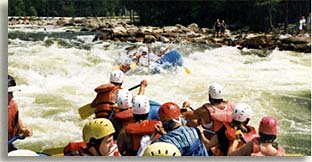
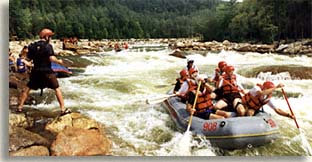
Ole' Blue Swimming Hole
Hot humid days bring to mind great escapes and it's this dry riverbed that has stimulated my interest this day. Here on the banks of this prehistoric river I remember my youth, when wishing for a little excitement on hot a summer days, would cause me to often seek out a cool place within the confines of liquid matter.
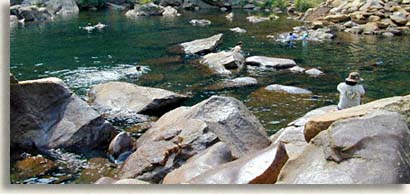
A slow current of low water flows continuously down the upper Ocoee, spilling gently over rocks and gathering into pools, some deep, some shallow. Within these pockets and pools is an escape from the outer world that could lead you into the comforts of a submerged wonder. Just outside the Ocoee Whitewater Center and scattered over nearly a mile up and down the dry bed of the Ocoee River are numerous swimming holes and wading pools formed out of large river stones along the Olympic course. Not necessarily a part of the Olympic plan, just the residue of the unforeseen.
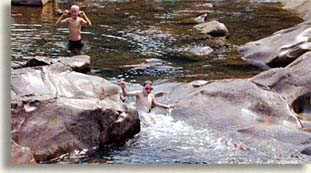
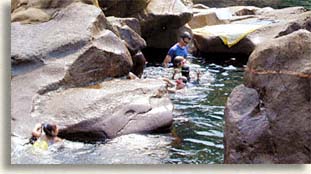
Located amongst the rocks and pools of the mountain waters you'll often find children and adults splashing, swimming, sliding down natural rock slide and sunbathing on the rocks or just soaking in a still pool alongside a school of fresh water trout. An accidental paradise, a throw back in time to a simpler place as natural as nature intended.
In the distance, up from the Ocoee Whitewater Center you can hear and see the fun and excitement of a large group of teenagers on summer vacation, they've taken command of the largest water hole, locally known as, "the Blue Hole," and from what I can tell, they never want to leave, but the local rangers have the last say here. The simple times when jumping off a tall river boulder and cannon balling into the large waterhole received cheering and approvals from your river peers.
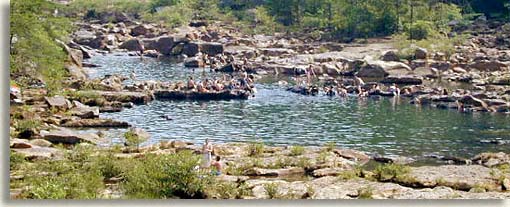
Just below the center west of the Legacy Bridge are the quieter sounds of small children with their parents enjoying priceless moments that will endure a lifetime. Some young couples sunbath on the large boulders while others play splashing and cuddling games in intimate pools all their own.
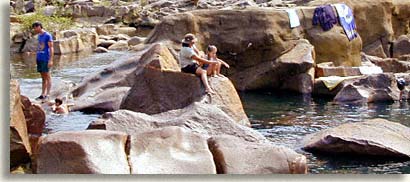
The scene reminds me of days long ago in Kentucky, when my cousins and I would slip away to the seclusion of an abandoned rock quarry that would fill up with water from underground sources and rain runoff. And, during my teen years, we would swim off the shores of what were called "the rocks," large square and rectangular stones, the size of small cars that were placed along the shores and in the water of Lake Michigan in Chicago. The rocks were placed there to protect the shoreline from erosion. You had a choice, climb across the rocks in the water or dive very shallowly between the rocks in order to get to the deeper lake water. Those were the times and memories that shaped the experiences of my youth, scenes from the Rockwell tales of Huckleberry Finn.
A word of caution from personal experience, swimming in such places like stone quarries, lakefront rocks and around whitewater boulders can be hazardous! Hard rock surfaces are unforgiving when it comes to rock meets flesh, accidents can measure from minor to fatal. These rocks can be slippery causing you to lose balance, foot entrapment between rocks can be a real problem, and some stone edges can be sharp causing cuts, abrasions or lesions. Not to mention .
Just the same, danger has often the greatest appeal to the adventure, ask a whitewater rafter who's taken a plunge and rode the river bareback just to come back and do it again. Parents with children must exercise rules of caution, and young adults...just be careful you want to live to be mature adults. Even wadding in small shallow pools can be delightful, yet sometimes slippery.
The bare rocks protruding above the river water and the shallow depths of fish laden pools are simply beautiful, inducing a sense of awe in nature as we connect with a remnant spirit from an ancient time.
The Ocoee Whitewater Center Park is unique in that it expresses in a special way, an experience that has been forged by nature, carved by the finger of time, a genuine natural wonder. Enjoy and respect the park it was created for all us.
the Highlander
Click here to read about the History of the Ocoee...
Click here to read Ancient Waters, Thrilling Ride
Occoe River Whitewater Release Schedule
Want to go rafting...use this link...
![]()
Sign
up for the Blue Ridge Highlander Newsletter, Messages from the Mountains
to find out first about our new feature stories, road trips and special offers
Your e-mail addresses will not be sold or given away to anyone.
Privacy
Policy
Interested in your business being on the Highlander, click here...
Let our visitors tell you about the Highlander...
Click the feathers to go to the Highlander site
map...

